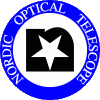|
Using StanCAM for ToO observations
StanCam is usually used for Target-Of-Opportunity observations if there is no
other optical
imaging device mounted, in practice: whenever Turpol or SOFIN are on.
If you are using NOTCam then check the page Using StanCam and NOTCam
together .
StanCam is prepared and cooled by staff, and as
a stand-by camera, it is quick and easy to switch between the currently mounted
instrument and StanCam.
-
Set 'remsave_on' to save the images in a remote directory from which
they are automatically transferred to the project PI. NB! Do not turn off
autosave! These files will be saved among yours, as well as in a remote
directory. If you are not using BIAS but the fast photometry program, then
copy the files to directory /data/exportdata/ as soon as images are
taken.
-
Depending on which ToO programme you are performing (e.g. Goobar, Hannikainen,
Nowotny, Fynbo, Pursimo, general), you have to set the remote image path
in the sequencer. Do this by rempath /data/service/PXX/030" (for example,
with XX the observing period number).
-
Set 'remsave_on' in sequencer to save the images in a remote directory
from which they are automatically transferred to the selected
project PI. NB! Do
not turn off autosave!
-
Move the mirror in the adaptor which feeds light to the StanCam CCD by
typing on the TCS 'CCD-probe-CCD'. Select the requested filter by
typing 'CCD-fil (n) , where (n) the number corresponding to a given
filter is found by typing 'CCD-fil' and the HELP button.
-
If flat fields are requested, then take 3-4 flat fields in each filter, either on
the twilight sky or during daytime using the dome lamp. There is a flat field lamp
to put on the dome floor in front of the telescope pointing towards the hatches.
Turn it on by connecting the cable to the mains, and remember to open the
mirror covers by typing m-c-o on the TCS.
(Remember the rempath and remsave options.)
-
Note down the focus value you use for your own observing, or save it by
the command 'focus-save'. Focus the telescope for StanCam by using the
suitable focus stars in the on-line catalogue blanks. Start a focus
sequence with the BIAS command:
'focus (focus start-value) (focus step-size) (exptime)',
setting the start value close to the nominal focus for StanCam (23080), the
step-size to around 100, and the exposure time to 5-10 seconds. The
telescope is now stepped in position and focus, such that the resulting image
will show a sequence of focus exposures with the last exposure offset 90
degrees to the others. Evaluate the best focus or iterate the procedure.
-
Preset to the object, wait for tracking, click the middle button of the autoguider
mouse on the guide star, and then start autoguiding by typing 'a-g'
on the TCS. You may need to set 'tv-fil open ' to see the guide star,
or you may need to adjust TV focus.
-
Make exposures according to the schedule with the command 'exp (ttt)
'. It is preferred to use about 15 arcsec dithering between multiple
exposures. While autoguiding you can use e.g. the command 'teloffset 0 15
' to move the telescope 15 arcsec to the north. Otherwise, stop guiding
and move with arrow keys after having set o-s 15 15.
-
After having observed all objects write 'remsave_off' in sequencer. Park the
CCD probe by typing 'CCD-probe-park' on the TCS. Load back your own
focus value (e.g. by 'focus-recall'), and continue
observations.
|

